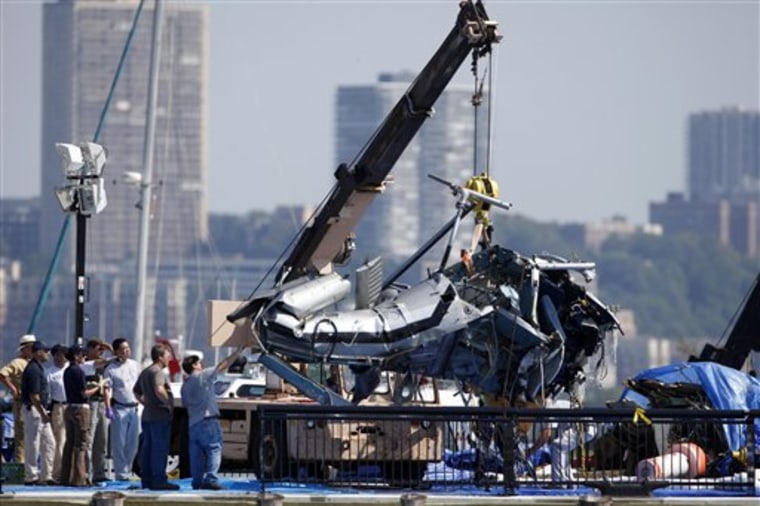The crowded airspace over the Hudson River, where nine people died in the collision of a small plane and a sightseeing helicopter, will be split into a low-altitude zone for local traffic and a higher one for longer-distance flights, the Federal Aviation Administration said Monday.
The new rules provide structure to a Hudson River air corridor that some pilots had compared to the wild West, with helicopters loaded with commuters and sightseers cutting across the waterway as fixed-wing private planes travel down it on longer journeys.
The changes, which follow recommendations in an FAA task force report compiled after the Aug. 8 collision, are to take effect Thursday.
"We're going to separate the aircraft by mission," FAA chief Randy Babbitt said. "What we have done with the airspace changes is to simplify, crystallize and essentially make a requirement for how you're going to operate."
Local planes and helicopters will be restricted to an altitude of 1,000 feet or less, said Babbitt. Those passing through the New York City area on longer flights to other destinations will operate between 1,000 feet and 1,300 feet.
Higher altitudes will continue to be reserved for scheduled airline flights and other operations requiring authorization and monitoring by air traffic controllers.
Speeds within the Hudson River air corridor, which stretches to about 20 miles northeast of the Statue of Liberty, will be restricted to 140 knots, or about 160 mph, or less.
Other changes include requiring southbound aircraft to travel along the New Jersey side of the river, while northbound traffic uses the New York side. The corridor also has been given a uniform ceiling of 1,300 feet, which will replace a maximum altitude that now varies by location from 1,000 feet to 1,500 feet.
Rules of the road
Matt Zuccaro, president of the International Helicopter Trade Association, said many of the 100 helicopter companies operating in the New York City area already observe similar rules voluntarily. The organization had called for aircraft on different missions to be separated by altitude.
"We support all of the changes," Zuccaro said. "There were no rules of the road before."
The helicopter involved in the fatal crash was rising and heading across the Hudson when the low-wing plane hit it. Five Italian tourists who were on a helicopter sightseeing tour were killed along with their pilot.
Three people died on the plane, a single-engine Piper traveling from Teterboro Airport in New Jersey to Ocean City, N.J.
Babbitt said Monday that the air traffic controller and supervisor who were on duty at Teterboro have been fired. They were previously suspended after an investigation found they weren't monitoring the pilot of the small plane as closely as they should have.
The controllers have appealed their termination and remain on paid leave during the process.
Schumer: Changes not enough
Plane pilot Steven Altman, 60, of Ambler, Pa., was unfamiliar with the corridor and had requested additional guidance from air traffic control. The Teterboro controller failed to notice that Altman read back the wrong radio frequency after being told to switch to the control tower at nearby Newark Liberty International Airport.
It's not clear whether Altman heard subsequent traffic warnings from controllers. The Teterboro controller's supervisor was out of the building on a personal errand.
Doug Church, a spokesman for the National Air Traffic Controllers Association, declined to comment on the firings.
Sen. Charles Schumer said Monday that the changes don't go far enough. He wants all aircraft in the corridor to be monitored continuously by air traffic controllers and to be required to file flight plans, just like commercial airliners.
"We appreciate the FAA's continued focus on closing this serious, gaping hole in air safety over New York City; unfortunately these rules leave the hole too wide open," said Schumer, a New York Democrat.
